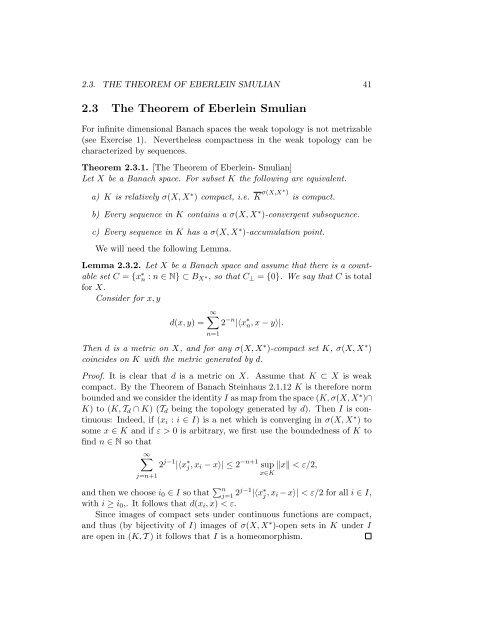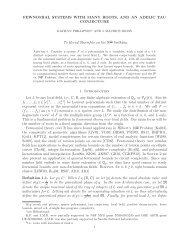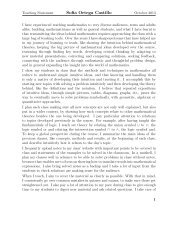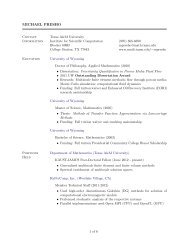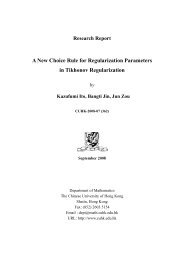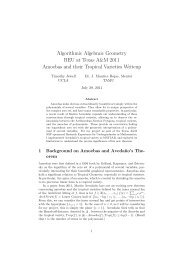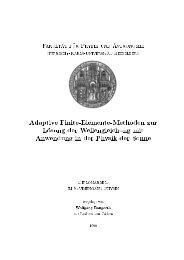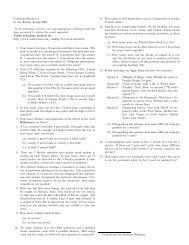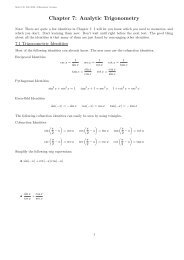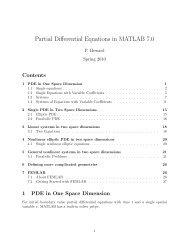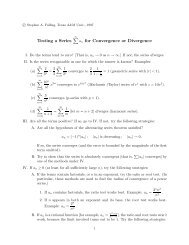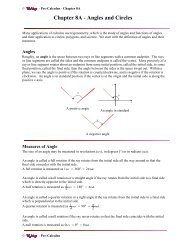2.3 The Theorem of Eberlein Smulian
2.3 The Theorem of Eberlein Smulian
2.3 The Theorem of Eberlein Smulian
Create successful ePaper yourself
Turn your PDF publications into a flip-book with our unique Google optimized e-Paper software.
<strong>2.3</strong>. THE THEOREM OF EBERLEIN SMULIAN 41<br />
<strong>2.3</strong> <strong>The</strong> <strong>The</strong>orem <strong>of</strong> <strong>Eberlein</strong> <strong>Smulian</strong><br />
For infinite dimensional Banach spaces the weak topology is not metrizable<br />
(see Exercise 1). Nevertheless compactness in the weak topology can be<br />
characterized by sequences.<br />
<strong>The</strong>orem <strong>2.3</strong>.1. [<strong>The</strong> <strong>The</strong>orem <strong>of</strong> <strong>Eberlein</strong>- <strong>Smulian</strong>]<br />
Let X be a Banach space. For subset K the following are equivalent.<br />
a) K is relatively σ(X, X ∗ ) compact, i.e. K σ(X,X∗ ) is compact.<br />
b) Every sequence in K contains a σ(X, X ∗ )-convergent subsequence.<br />
c) Every sequence in K has a σ(X, X ∗ )-accumulation point.<br />
We will need the following Lemma.<br />
Lemma <strong>2.3</strong>.2. Let X be a Banach space and assume that there is a countable<br />
set C = {x ∗ n : n ∈ N} ⊂ BX ∗, so that C⊥ = {0}. We say that C is total<br />
for X.<br />
Consider for x, y<br />
d(x, y) =<br />
∞�<br />
2 −n |〈x ∗ n,x− y〉|.<br />
n=1<br />
<strong>The</strong>n d is a metric on X, and for any σ(X, X ∗ )-compact set K, σ(X, X ∗ )<br />
coincides on K with the metric generated by d.<br />
Pro<strong>of</strong>. It is clear that d is a metric on X. Assume that K ⊂ X is weak<br />
compact. By the <strong>The</strong>orem <strong>of</strong> Banach Steinhaus 2.1.12 K is therefore norm<br />
bounded and we consider the identity I as map from the space (K, σ(X, X ∗ )∩<br />
K) to (K, Td ∩ K) (Td being the topology generated by d). <strong>The</strong>n I is continuous:<br />
Indeed, if (xi : i ∈ I) is a net which is converging in σ(X, X ∗ ) to<br />
some x ∈ K and if ε> 0 is arbitrary, we first use the boundedness <strong>of</strong> K to<br />
find n ∈ N so that<br />
∞�<br />
j=n+1<br />
2 j−1 |〈x ∗ j,xi − x〉| ≤ 2 −n+1 sup �x� < ε/2,<br />
x∈K<br />
and then we choose i0 ∈ I so that � n<br />
j=1 2j−1 |〈x ∗ j ,xi − x〉| < ε/2 for all i ∈ I,<br />
with i ≥ i0,. It follows that d(xi,x)
42CHAPTER 2. WEAK TOPOLOGIES, REFLEXIVITY, ADJOINT OPERATORS<br />
Lemma <strong>2.3</strong>.3. Assume that X is separable. <strong>The</strong>n there is a countable total<br />
set C ⊂ X ∗ .<br />
Pro<strong>of</strong>. Let D ⊂ X be dense, and choose by the Corollary 1.4.6 <strong>of</strong> the <strong>The</strong>orem<br />
<strong>of</strong> Hahn Banach for each element x ∈ D, an element y∗ x ∈ SX∗ so<br />
that 〈y∗ x,x〉 = �x�. Put C = {y∗ x : x ∈ D}. If x ∈ X, x �= 0, is arbitrary<br />
then there is a sequence (xk) ⊂ D, so that limk→∞ xk = x, and thus<br />
limk→∞〈y∗ xk ,x〉 = �x� > 0. Thus there is a x∗ ∈ C so that 〈x∗ ,x〉�= 0,<br />
which implies that C is total.<br />
Pro<strong>of</strong> <strong>of</strong> <strong>The</strong>orem <strong>2.3</strong>.1. “(a)⇒(b)” Assume that K is σ(X, X ∗ )-compact<br />
(if necessary, pass to the closure) and let (xn) ⊂ K be a sequence, and put<br />
X0 = span(xn : n ∈ N). X0 is a separable Banach space. By Proposition<br />
2.1.5 the topology σ(X0,X ∗ 0 ) coincides with the restriction <strong>of</strong> σ(X, X∗ ) to<br />
X0. It follows therefore that K0 = K ∩ X0 is σ(X0,X∗ 0 )-compact. Since X0<br />
is separable, by Lemma <strong>2.3</strong>.3 there exists a countable set C ⊂ BX∗, so that<br />
0<br />
C⊥ = {0}.<br />
It follows therefore from Lemma <strong>2.3</strong>.2 that (K0,σ(X0,X∗ 0 ) ∩ K0) is<br />
metrizable and thus (xn) has a convergent subsequence in K0. Again, using<br />
the fact that on X0 the weak topology coincides with the weak topology on<br />
X, we deduce our claim.<br />
“(b)⇒(c)” clear.<br />
“(c)⇒(a)” Assume K ⊂ X satisfies (c). We first observe that K is (norm)<br />
bounded. Indeed, for x∗ ∈ X∗ , the set Ax∗ = {〈x∗ ,x〉 : x ∈ K} ⊂ K is<br />
the continuous image <strong>of</strong> A (under x∗ ) and thus has the property that every<br />
sequence has an accumulation point in K. This implies that Ax∗ is bounded<br />
in K for all x∗ ∈ X∗ , but this implies by the Banach Steinhaus <strong>The</strong>orem<br />
2.1.13 that A ⊂ X must be bounded.<br />
Let χ : X ↩→ X∗∗ be the canonical embedding. By the <strong>The</strong>orem <strong>of</strong><br />
Alaoglu 2.1.8, it follows that χ(K) σ(X∗∗ ,X ∗ ) is σ(X ∗∗ ,X ∗ )-compact. <strong>The</strong>re-<br />
fore it will be enough to show that χ(K) σ(X∗∗ ,X ∗ ) ⊂ χ(x) (because this<br />
would imply that every net (χ(xi) :i ∈ I) ⊂ χ(K) has a subnet which<br />
σ(χ(X),X ∗ )) converges to some element χ(x) ∈ χ(X)).<br />
So fix x ∗∗<br />
0 ∈ χ(K)σ(X∗∗ ,X ∗ ) . Recursively we will choose for each k ∈ N,<br />
xk ∈ K, finite sets A ∗ k ⊂ SX ∗, if k ∈ N0, so that<br />
(<strong>2.3</strong>)<br />
�<br />
�〈x ∗∗<br />
0 − χ(xk),x ∗ 〉 � � < 1<br />
k for all x∗ ∈ �<br />
0≤j
<strong>2.3</strong>. THE THEOREM OF EBERLEIN SMULIAN 43<br />
(2.4)<br />
∀ x ∗∗ ∈span(x ∗∗<br />
0 ,χ(xj), 1≤j ≤k) �x ∗∗ �≥ max<br />
x ∗ ∈A ∗ k<br />
For k = 0 choose A ∗ 0 = {x∗ }, x ∗ ∈ SX ∗ , with |x ∗ (x ∗∗<br />
0<br />
|〈x ∗∗ ,x ∗ 〉| ≥ �x∗∗� .<br />
2<br />
)|≥� x∗∗ 0 �/2, then<br />
condition (2.4) is satisfied, while condition (<strong>2.3</strong>) is vacuous.<br />
Assuming that x1,x2, . . . xk−1 and A∗ 0 ,A∗1 , . . . , A∗ k−1 have been chosen for<br />
some k>1, we can first choose xk ∈ K so that (<strong>2.3</strong>) is satisfied (since A∗ j is<br />
finite for j =1, 2, . . . k − 1), and then, since span(x∗∗ 0 ,χ(xj),j≤k) is a finite<br />
dimensional space we can choose A∗ k ⊂ SX∗ so that (2.4) holds.<br />
By our assumption (c) the sequence (xk) has an σ(X, X∗ )- accumulation<br />
point x0. By Proposition 2.1.7 it follows that x0 ∈ Y = span(xk : k ∈N) �·� =<br />
span(xk : k ∈N) σ(X,X∗ ) .<br />
We will show that x ∗∗<br />
0 = χ(x0) (which will finish the pro<strong>of</strong> ). First note<br />
that for any x ∗ ∈ �<br />
j∈N A∗ j<br />
�<br />
� 〈x ∗∗<br />
0 − χ(x0),x ∗ 〉 � � ≤ lim inf<br />
k→∞<br />
�� �〈x ∗∗<br />
0 − χ(xk),x ∗ 〉 � � + � �〈x ∗ ,xk − x0〉 � � � =0.<br />
Secondly consider the space Z = span(x∗∗ 0 ,χ(xk),k∈N) �·� ⊂ X∗∗ it follows<br />
from (2.4) that the set <strong>of</strong> restrictions <strong>of</strong> elements <strong>of</strong> �∞ k=1 A∗ k to Y is total<br />
in Z and thus that<br />
x ∗∗<br />
� �∞<br />
�<br />
0 − χ(x0) ∈ Z ∩<br />
= {0},<br />
which implies our claim.<br />
Exercises<br />
1. Prove that if X is a separable Banach space (BX ∗,σ(X∗ ,X)) is metrizable.<br />
2.∗ For an infinite dimensional Banach space prove that (X, σ(X, X ∗ )) is<br />
not metrizable.<br />
Hint: Exercise 4 in Section 2.1<br />
3. Prove that for two Banach spaces X and Y , the adjoint <strong>of</strong> a linear<br />
bounded operator T : X → Y is w ∗ continuous (i.e σ(Y ∗ ,Y) −<br />
σ(X ∗ ,X)continuous).<br />
k=1<br />
A ∗ k<br />
4. Show that ℓ1 isometric to a subspace <strong>of</strong> C[0, 1].<br />
5.∗ Show that ℓ1 is not complemented in C[0, 1].<br />
⊥
44CHAPTER 2. WEAK TOPOLOGIES, REFLEXIVITY, ADJOINT OPERATORS<br />
2.4 <strong>The</strong> Principle <strong>of</strong> Local Reflexivity<br />
In this section we we pro<strong>of</strong> a result <strong>of</strong> J. Lindenstrauss and H. Rosenthal<br />
[LR] which states that for a Banach space X the finite dimensional subspaces<br />
<strong>of</strong> the bidual X ∗∗ are in a certain similar to the finite dimensional subspaces<br />
<strong>of</strong> X.<br />
<strong>The</strong>orem 2.4.1. [LR] [<strong>The</strong> Principle <strong>of</strong> Local Reflexivity]<br />
Let X be a Banach space and let F ⊂ X ∗∗ and G ⊂ X ∗ be finite dimensional<br />
subspaces <strong>of</strong> X ∗∗ and X ∗ respectively.<br />
<strong>The</strong>n, given ε> 0, there is a subspace E <strong>of</strong> X containing F ∩ X (we<br />
identify X with its image under the canonical embedding) with dim E =<br />
dim F and an isomorphism T : F → E with �T �·� T −1 �≤1+ε such that<br />
(2.5)<br />
(2.6)<br />
T (x) =x if x ∈ F ∩ X and<br />
〈x ∗ ,T(x ∗∗ )〉 = 〈x ∗∗ ,x ∗ 〉 if x ∗ ∈ G, x ∗∗ ∈ F.<br />
We need several Lemmas before we can prove <strong>The</strong>orem 2.4.1. <strong>The</strong> first<br />
one is a corollary the Geometric Hahn-Banach <strong>The</strong>orem<br />
Proposition 2.4.2. [Variation <strong>of</strong> Geometrical Version <strong>of</strong> the <strong>The</strong>orem <strong>of</strong><br />
Hahn Banach]<br />
Assume that X is a Banach space and C ⊂ X is convex with C ◦ �= ∅<br />
and let x ∈ X \ C (so x could be in the boundary <strong>of</strong> C). <strong>The</strong>n there exists<br />
an x ∗ ∈ X ∗ so that<br />
ℜ〈x ∗ ,z〉 < 1=〈x ∗ ,x〉 for all z ∈ C 0 ,<br />
and, if moreover C is absolutely convex (i.e. if ρx ∈ C for all x ∈ C and<br />
ρ ∈ K, with |ρ| ≤ 1), then<br />
|〈x ∗ ,z〉| < 1=〈x ∗ ,x〉 for all z ∈C 0 .<br />
Lemma 2.4.3. Assume T : X → Y is a bounded linear operator between<br />
the Banach spaces X and Y and assume that T (X) is closed.<br />
Suppose that for some y ∈ Y there is an x ∗∗ ∈ X ∗∗ with �x ∗∗ � < 1, so<br />
that T ∗∗ (x ∗∗ )=y. <strong>The</strong>n there is an x ∈ X, with �x� < 1 so that T (x) =y.<br />
Pro<strong>of</strong>. We first show that there is an x ∈ X so that T (x) =y. Assume this<br />
where not true, then we could find by the Hahn-Banach <strong>The</strong>orem (Corollary<br />
1.4.5) an element y ∗ ∈ Y ∗ so that y ∗ (z) = 0 for all z ∈ T (X) and 〈y ∗ ,y〉 =1
2.4. THE PRINCIPLE OF LOCAL REFLEXIVITY 45<br />
(T (X) is closed). But this yields 〈T ∗ (y ∗ ),x〉 = 〈y ∗ ,T(x)〉 = 0, for all x ∈ X,<br />
and, thus, T ∗ (y ∗ ) = 0. Thus<br />
0=〈x ∗∗ ,T ∗ (y ∗ )〉 = 〈T ∗∗ (x ∗∗ ),y ∗ 〉 = 〈y, y ∗ 〉 =1,<br />
which is a contradiction.<br />
Secondly assume that y ∈ T (X) \ T (B◦ X ). Since T is surjective onto its<br />
(closed) image Z = T (X) it follows from the Open Mapping <strong>The</strong>orem that<br />
T (B◦ X ) is open in Z, and we can use the geometric version <strong>of</strong> the Hahn-<br />
Banach <strong>The</strong>orem 1.4.12 , to find z∗ ∈ Z∗ so that 〈z∗ ,T(x)〉 < 1=〈z∗ ,y〉<br />
for all x ∈ B◦ X . Again by the <strong>The</strong>orem <strong>of</strong> Hahn-Banach (Corollary 1.4.4) we<br />
can extend z ∗ to an element y ∗ in Y ∗ . It follows that<br />
�T ∗ (y ∗ )� = sup<br />
x∈B◦ 〈T<br />
X<br />
∗ (y ∗ ),x〉 = sup<br />
x∈B◦ 〈z<br />
X<br />
∗ ,T(x)〉 ≤1,<br />
and thus, since �x ∗∗ � < 1, it follows that<br />
which is a contradiction.<br />
|〈y ∗ ,y〉| = |〈y ∗ ,T ∗∗ (x ∗∗ )〉| = |〈x ∗∗ ,T ∗ (y ∗ )〉| < 1,<br />
Lemma 2.4.4. Let T : X → Y be a bounded linear operator between two<br />
Banach spaces X and Y with closed range, and assume that F : X → Y has<br />
finite rank.<br />
<strong>The</strong>n T + F also has closed range.<br />
Pro<strong>of</strong>. Assume the claim is not true. <strong>The</strong>n, by Proposition 1.3.10, we can<br />
choose a sequence (xn) so that<br />
lim<br />
n→∞ (T + F )(xn) = 0 and dist(xn, N (T + F )) ≥ 1.<br />
Since the sequence (F (xn) :n ∈ N) is a bounded sequence in a finite<br />
dimensional space, we can, after passing to a subsequence, assume that<br />
(F (xn) :n∈N) converges to some y ∈ Y and, hence,<br />
lim<br />
n→∞ T (xn) =−y.<br />
Since T has closed range there is an x ∈ X, so that T (x) =−y. Using again<br />
the equivalences in Proposition 1.3.10 and the fact that T (xn) →−y = T (x),<br />
if n ↗∞, it follows for some constant C>0 that<br />
lim<br />
n→∞ dist(x − xn, N (T )) ≤ lim<br />
n→∞ C�T (x − xn)� =0,
46CHAPTER 2. WEAK TOPOLOGIES, REFLEXIVITY, ADJOINT OPERATORS<br />
and, thus,<br />
y − F (x) = lim<br />
n→∞ F (xn) − F (x) ∈ F (N (T )),<br />
so we can write y − F (x) as<br />
y − F (x) =F (u), where u ∈N (T ).<br />
Thus<br />
lim<br />
n→∞ dist(xn − x − u, N (T )) = 0 and<br />
lim<br />
n→∞ �F (xn) − F (x) − F (u)� =0.<br />
F | N (T ) has also closed range, Proposition 1.3.10 yields (C being some positive<br />
constant)<br />
lim sup<br />
n→∞<br />
dist(xn−x−u, N (F )∩N (T )) ≤ lim sup C�F (xn)−F (x)−F (u)� =0.<br />
n→∞<br />
Since T (x+u) =−y = −F (x+u) (by choice <strong>of</strong> u), and thus (T +F )(x+u) =<br />
0 which means that x + u ∈N (T + F ). <strong>The</strong>refore<br />
lim sup<br />
n→∞<br />
dist(xn, N (T + F )) = lim sup dist(xn − x − u, N (T + F ))<br />
n→∞<br />
≤ lim sup dist(xn − x − u, N (T ) ∩N (F )) = 0.<br />
n→∞<br />
But this contradicts our assumption on the sequence (xn).<br />
Lemma 2.4.5. Let X be a Banach space, A =(ai,j)i≤m,j≤n an m be n<br />
matrix and B =(bi,j)i≤p,j≤n a p by n matrix, and that B has only real<br />
entries (even if K = C).<br />
Suppose that y1, . . . ym ∈ X, y ∗ 1 , . . . y∗ p ∈ X ∗ , ξ1, . . . ξp ∈ R, and x ∗∗<br />
1<br />
B◦ X∗∗ satisfy the following equations:<br />
(2.7)<br />
(2.8)<br />
n�<br />
j=1<br />
�<br />
y ∗ i ,<br />
ai,jx ∗∗<br />
j = yi, for all i =1, 2 . . . m, and<br />
n�<br />
j=1<br />
bi,jx ∗∗<br />
�<br />
j = ξi, for all i =1, 2 . . . p.<br />
<strong>The</strong>n there are vectors x1, . . . xn ∈ B◦ X satisfying:<br />
n�<br />
(2.9)<br />
ai,jxj = yi, for all i =1, 2 . . . m, and<br />
(2.10)<br />
j=1<br />
�<br />
y ∗ i ,<br />
n�<br />
j=1<br />
bi,jxj<br />
�<br />
= ξi, for all i =1, 2 . . . p.<br />
, . . . x∗∗<br />
n ∈
2.4. THE PRINCIPLE OF LOCAL REFLEXIVITY 47<br />
Pro<strong>of</strong>. Recall from Linear Algebra that we can write the matrix A as a<br />
product A = U ◦ P ◦ V , where U and V are invertible and P is <strong>of</strong> the form<br />
P =<br />
� �<br />
Ir 0<br />
,<br />
0 0<br />
where r is the rank <strong>of</strong> A and Ir the identity on K r .<br />
For a general s by t matrix C =(ci,j)i≤s,j≤t consider the operator<br />
TC : ℓ t ∞(X) → ℓ s � �t<br />
�<br />
∞(X), (x1,x2, . . . xt) ↦→ ci,jxj : i =1, 2 . . . m .<br />
If s = t and if C is invertible then TC is an isomorphism. Also if C (1) and<br />
C (2) are two matrices so that the number <strong>of</strong> columns <strong>of</strong> C (1) is equal to the<br />
number <strong>of</strong> rows <strong>of</strong> C (2) one easily computes that T C (1) ◦C (2) = T C (1) ◦ T C (2).<br />
Secondly it is clear that TP is a closed operator (P defined as above), since<br />
TP is simply the projection onto the first r coordinates in ℓ n ∞(X).<br />
It follows therefore that TA = TU ◦ TP ◦ TV is an operator with closed<br />
range. Secondly define the operator<br />
SA : ℓ n ∞(X) → ℓ m ∞(X) ⊕ ℓ p ∞,<br />
�<br />
(x1, . . . xn) ↦→<br />
TA(x1, . . . xn),<br />
��<br />
y ∗ i ,<br />
j=1<br />
n�<br />
j=1<br />
bi,jxj<br />
SA can be written as the sum <strong>of</strong> SA and a finite rank operator and has<br />
therefore also closed range by Lemma 2.4.4.<br />
is the operator<br />
with<br />
Since the second adjoint <strong>of</strong> S ∗∗<br />
A<br />
S ∗∗<br />
A : ℓ n ∞(X ∗∗ ) → ℓ m ∞(X ∗∗ ) ⊕ ℓ p ∞,<br />
�<br />
(x ∗∗<br />
1 , . . . x ∗∗<br />
n ) ↦→<br />
T ∗∗<br />
A (x ∗∗<br />
1 , . . . x ∗∗<br />
n ),<br />
��<br />
y ∗ i ,<br />
T ∗∗<br />
A : ℓ n ∞(X ∗∗ ) → ℓ m ∞(X ∗∗ ), (x ∗∗<br />
1 ,x ∗∗<br />
2 , . . . x ∗∗<br />
n ) ↦→<br />
our claim follows from Lemma 2.4.3.<br />
n�<br />
j=1<br />
� t �<br />
j=1<br />
�� p<br />
i=1<br />
�<br />
bi,jx ∗∗<br />
�<br />
��p j<br />
i=1<br />
.<br />
ai,jx ∗∗<br />
�<br />
j : i =1, 2 . . . m ,
48CHAPTER 2. WEAK TOPOLOGIES, REFLEXIVITY, ADJOINT OPERATORS<br />
Lemma 2.4.6. Let E be a finite dimensional space and (xi) N i=1 is an ε-net<br />
<strong>of</strong> SE for some 0 < ε < /3. If T : E → E is a linear map so that<br />
<strong>The</strong>n<br />
and thus<br />
(1 − ε) ≤�T (xj)� ≤(1 + ε), for all j =1, 2 . . . N.<br />
1 − 3ε<br />
1 − ε<br />
�x� ≤�T (x)� ≤1+ε�x�,<br />
for all x∈E,<br />
1 − ε<br />
�T �·� T −1 �≤<br />
(1 + ε) 2<br />
(1 − ε)(1 − 3ε) .<br />
Pro<strong>of</strong>. Let x ∈ X. W.l.o.g. we can assume that �x� = 1. Pick j ≤ N so<br />
that �x − xj� ≤ε. <strong>The</strong>n<br />
�T (x)� ≤�T (x) − T (xj)� + �T (xj)� ≤ε�T � +1+ε,<br />
and thus<br />
�T �≤ 1+ε<br />
1 − ε ,<br />
which implies the second inequality <strong>of</strong> our claim. We also have<br />
�T (x)� ≥ �T (xj)�−�T (x−xj)� ≥1−ε−ε 1+ε<br />
1 − ε = 1 − 2ε + ε2 − ε − ε2 1 − ε<br />
which proves our claim.<br />
We are now ready to pro<strong>of</strong> <strong>The</strong>orem 2.4.1.<br />
Pro<strong>of</strong> <strong>of</strong> <strong>The</strong>orem 2.4.1. Let F ⊂ X∗∗ and G ⊂ X∗ be finite dimensional<br />
subspaces, and let 0 < ε < 1. Choose δ> 0, so that<br />
2.4. THE PRINCIPLE OF LOCAL REFLEXIVITY 49<br />
choose x∗ 1 ,x∗2 , . . . , x∗ N ∈ SX∗ so that 〈x∗∗ j ,x∗j 〉 > 1 − δ, and pick basis<br />
{g∗ 1 ,g∗ 2 , . . . g∗ ℓ } <strong>of</strong> G.<br />
Consider the following system <strong>of</strong> equations in N unknowns z∗∗ 1 , z∗∗ 2 ,<br />
. . . , z∗∗ N in X∗∗ :<br />
N�<br />
j=1<br />
ai,jz ∗∗<br />
j = yi for i =1, 2 . . . m<br />
〈z ∗∗<br />
j ,x ∗ j〉 = 〈x ∗∗<br />
j ,x ∗ j〉 for j =1, 2 . . . N and<br />
〈z ∗∗<br />
j ,gk〉 = 〈x ∗∗<br />
j ,g ∗ k 〉 for j =1, 2 . . . N and k =1, 2 . . . ℓ.<br />
By construction z∗∗ j = x∗∗ j , j =1, 2 . . . N, is a solution to these equations.<br />
Since �x∗∗ j � =1< 1+δ, for j =1, 2 . . . N, we can use Lemma 2.4.5 and<br />
find x1,x2, . . . xN ∈ X, with �xj� =1< 1+δ, for j =1, 2 . . . N, which solve<br />
above equations.<br />
Define<br />
S1 : R N N�<br />
→ X, (ξ1,ξ2 . . . ξN) ↦→ ξjxj.<br />
We claim that the null space <strong>of</strong> S is contained in the null space <strong>of</strong> S1. Indeed<br />
if we assumed that ξ ∈ KN , and �N j=1 ξjxj, but �N j=1 x∗∗ j �= 0, then there<br />
is an i ∈{1, 2, . . . N} so that<br />
�<br />
x ∗ i ,<br />
N�<br />
j=1<br />
x ∗∗<br />
�<br />
j �= 0,<br />
but since 〈x∗∗j,x∗ i 〉 = 〈xj,x∗ i 〉 this is a contradiction.<br />
It follows therefore that we can find a linear map T : F → X so that<br />
S1 = TS. Denoting the standard basis <strong>of</strong> RN by (ei)i≤N we deduce that<br />
xi = S1(ei) =T ◦ S(ei) =T (x∗∗ j ), and thus<br />
j=1<br />
1+δ> �xj� = �T (x ∗∗<br />
j )� ≥ |〈x ∗ j,xj〉| = 〈x ∗∗<br />
j ,x ∗ j〉| > 1 − δ.<br />
By Lemma 2.4.6 and the choice <strong>of</strong> δ it follows therefore that �T � · �T −1 �≤<br />
1+ε.<br />
Note that for ξ ∈H = S −1 (F ∩ X), say ξ = � m<br />
i=1 βia (i) , we compute<br />
S1(ξ) =<br />
m�<br />
βiS1(a (i) )=<br />
i=1<br />
m�<br />
βi<br />
i=1 j=1<br />
N�<br />
ai,jxj =<br />
m�<br />
N�<br />
βi<br />
i=1 j=1<br />
We deduce therefore for x ∈ F ∩ X, that T (x) =x.<br />
ai,jx ∗∗<br />
j =<br />
m�<br />
βiS(a (i) )=S(ξ).<br />
i=1
50CHAPTER 2. WEAK TOPOLOGIES, REFLEXIVITY, ADJOINT OPERATORS<br />
Finally from the third part <strong>of</strong> the system <strong>of</strong> equations it follows, that<br />
〈x ∗ ,T(x ∗∗<br />
j )〉 = 〈x ∗ ,xj〉 = 〈x ∗ ,xj〉, for all j =1, 2 . . . N and x ∗ ∈G,<br />
and, thus (since the x ∗∗<br />
j<br />
Exercises<br />
generate all <strong>of</strong> F ), that<br />
〈x ∗ ,T(x ∗∗ )〉 = 〈x ∗∗ ,x ∗ 〉, for all x ∗∗ ∈F and x ∗ ∈G.<br />
1. Prove Proposition 2.4.2.


